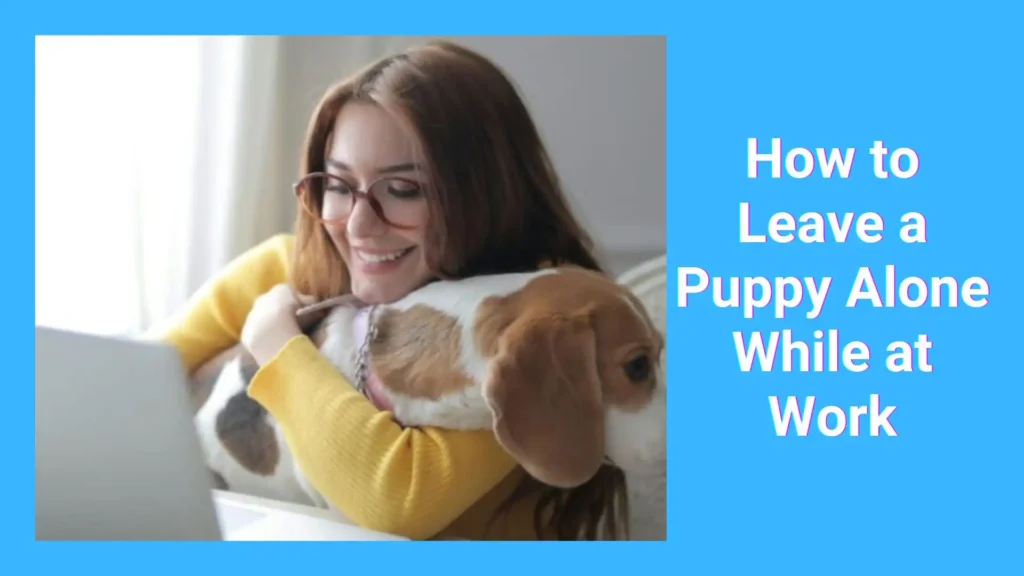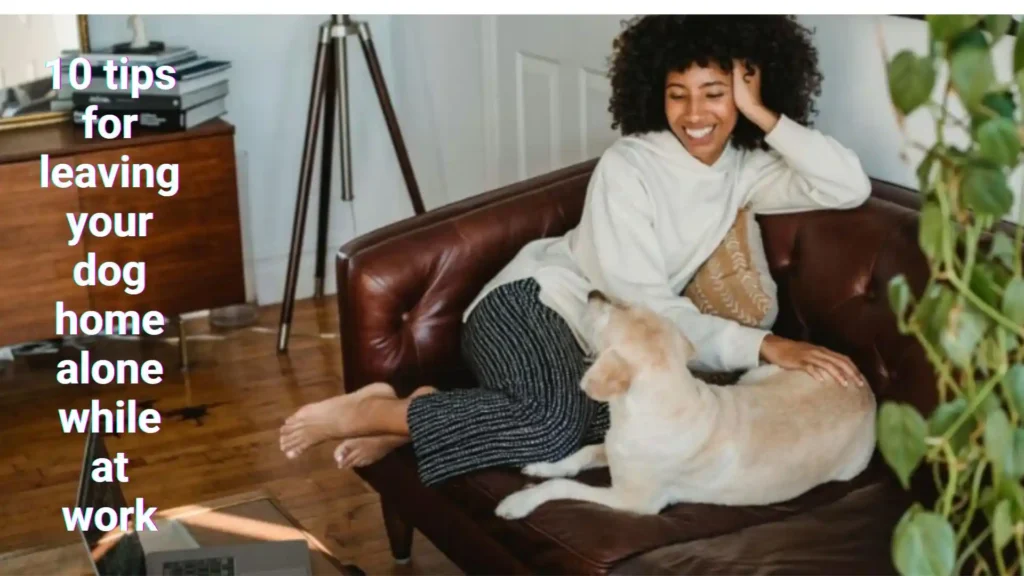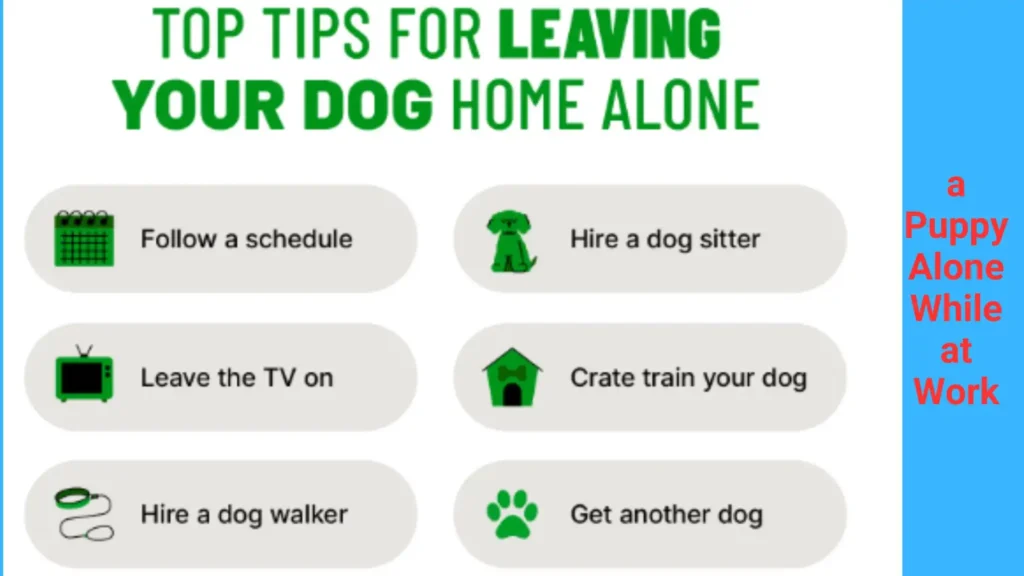As an Amazon Associate, I earn from qualifying purchases
Puppy Alone While at Work: Welcoming a new puppy into your home is a thrilling and heartwarming experience, but it brings with it important responsibilities. One of the biggest challenges for many pet owners is managing the time spent away from their new furry companion, especially if they work full-time. Puppies need constant care, supervision, and attention in their early stages of life to ensure they grow up healthy, happy, and well-behaved.
Leaving a puppy alone while at work can be a daunting task, but with the right strategies and preparations, it could be done without causing undue stress on the puppy or the owner.

In this post, we’ll walk through essential tips and strategies to help you leave your puppy alone while you’re at work. From creating a safe environment to developing a schedule, providing mental stimulation, and more, we’ll cover everything you need to know to make this transition smooth for both you and your pet.
How to Leave Your Dog Home Alone: 8 Best Practices
Leaving your dog at home alone can cause stress for both you and your furry companion. Dogs are social animals and may struggle with separation, boredom, or anxiety when left unattended for long periods.
However, with proper planning and preparation, you can ensure that your dog remains safe, comfortable, and content while you’re away. Here are eight effective tips for leaving your dog home alone.
Create a Safe Space For a Puppy Alone While at Work
Include the following in your dog’s safe space:
a. A comfortable bed or blanket
b. Freshwater
c. Safe chew toys or interactive toys to keep them busy
d. Access to a potty area (if they are not yet fully house-trained)
Monitor Your Dog with Technology
Pet cameras are a great way to check in on your dog while you’re away. Some cameras allow you to interact with your dog, talk to them, or even dispense treats. Monitoring your dog’s behavior in real time can give you peace of mind and help you understand how they handle being alone.
Provide Sufficient Exercise Before Leaving
Before you leave your dog home alone, make sure they’ve had enough physical exercise. Taking your dog for a long walk, playing a game of fetch, or visiting the dog park are great ways to help them burn off extra energy. A tired dog is more likely to relax and rest while you’re away, rather than engaging in destructive behaviors out of boredom.
Offer Mental Stimulation
Dogs require mental stimulation just as much as they do physical exercise. Leaving your dog with puzzle toys, treat-dispensing toys, or stuffed Kongs can keep them engaged and entertained for hours. These toys help prevent boredom and anxiety, keeping your dog’s mind active even when they’re alone.
Maintain a Consistent Routine
Dogs thrive on routine. Establishing a regular schedule for feeding, walks, playtime, and bathroom breaks will help your dog understand what to expect each day. Try to leave and return home at the same time whenever possible. A consistent routine helps reduce anxiety and makes it easier for your dog to adapt to being alone.
Use a Dog Walker or Pet Sitter
If you’re going to be gone for an extended period, consider hiring a dog walker or pet sitter to check in on your dog. A midday walk or visit can give your dog a chance to relieve themselves, get some exercise, and enjoy social interaction. This break in the day can make a significant difference, especially for dogs prone to separation anxiety or those who need more frequent bathroom breaks.
Gradually Increase Alone Time
If your dog isn’t used to being alone, start by leaving them alone for short periods and gradually increase the time. This helps your dog build confidence and reduces the risk of separation anxiety. Begin with 10-15 minutes and slowly work your way up to a few hours, always rewarding your dog for calm behavior when you return.
Consider Calming Aids
If your dog struggles with anxiety when left alone, calming aids can help. Products such as pheromone diffusers, calming sprays, or anxiety wraps like Thundershirts can provide comfort and reduce stress. Some dogs also benefit from background noise, such as leaving the TV or radio on, which can create a sense of company.
Leaving your dog home alone doesn’t have to be a source of anxiety for you or your pet. By following these eight best practices, you can ensure your dog remains safe, comfortable, and entertained while you’re away.
10 tips for leaving your dog home alone while at work

Here are some helpful tips for leaving your dog home alone while you’re at work:
- Give Plenty of Exercises
Take your dog for a walk or engage in playtime before you leave. This helps burn off energy, making them more likely to relax and nap while you’re away. - Create a Safe, Comfortable Space
Set up a cozy area for your dog with their bed, toys, and fresh water. This space should be free of hazards, and crate training can offer a sense of security. - Provide Mental Stimulation
Leave interactive toys, puzzle feeders, or treat-dispensing toys to keep your dog mentally occupied. - Stick to a Routine
Dogs thrive on routine, so try to leave and return at the same time each day. This helps them adjust to your absence and creates predictability. - Use a Pet Camera
Consider setting up a pet camera to check in on your dog throughout the day. Some cameras even allow you to talk to your dog or dispense treats remotely. - Arrange a Midday Visit
If you’re gone for long hours, arrange for a dog walker, friend, or pet sitter to check in, walk your dog, and provide bathroom breaks. - Keep Them Entertained
Leave the TV or radio on low volume for some background noise. This could create a calming atmosphere and mimic the sounds of companionship. - Gradually Increase Alone Time
Practice leaving your dog alone for shorter periods before building up to full workdays. This gradual approach helps reduce anxiety and builds confidence. - Consider Doggy Daycare
For very social dogs, doggy daycare can be a great option. They’ll have plenty of interaction, exercise, and playtime while you’re at work. - Monitor Their Bathroom Needs
Make sure your dog has a bathroom break right before you leave, and provide indoor potty options like pee pads for puppies.
These tips could help ease your dog’s transition into being home alone, ensuring they stay safe, happy, and calm throughout the day.
Use a Pet Camera or Monitor
If you’re worried about leaving your puppy alone, consider using a pet camera. These devices allow you to check in on your puppy throughout the day, and some models even let you talk to them or dispense treats remotely. It’s a great way to ease your worries and make sure they’re adjusting well to being alone.
How long can you leave your dog alone?
The length of time you could leave your dog alone depends on several factors, including their age, breed, and temperament. Here’s a general guide:
A. Puppies (under 6 months)
Puppies have small bladders and need frequent bathroom breaks. They shouldn’t be left alone for more than 2-3 hours at a time, as they need social interaction, potty breaks, and training.
B. Adult Dogs (1-6 years)
Most adult dogs can be left alone for 4-6 hours, provided they have been properly trained and exercised. More independent dogs can handle 8 hours if they have a safe space, water, and entertainment.
C. Senior Dogs (7 years and older)
Older dogs may need more bathroom breaks and attention due to age-related health issues. It’s best not to leave them alone for more than 4-6 hours.
D. Breeds with High Energy or Separation Anxiety
Some breeds, like Border Collies or German Shepherds, have high energy levels and may struggle with long periods alone.
Finally, it’s ideal to break up their day with bathroom breaks, exercise, and some companionship. Consider options like dog walkers, pet sitters, or doggy daycare for longer workdays.
Signs your dog is having separation anxiety
Separation anxiety in dogs can manifest through a range of behaviors that typically occur when they are left alone. Here are some common signs:
A. Excessive Barking or Howling
Dogs with separation anxiety may bark, howl, or whine persistently when left alone. This is often a sign of distress.
B. Destructive Behavior
Chewing furniture, scratching doors, or trying to escape are common destructive behaviors. Dogs may damage items near entryways in an attempt to reunite with their owners.
C. Accidents Indoors
House-trained dogs may urinate or defecate inside the house due to anxiety, even if they’ve just been outside.
D. Excessive Salivation, Drooling, or Panting
Dogs experiencing separation anxiety may show physical signs of stress, such as excessive drooling or panting, even when they are not physically active
E. Self-Injury
In extreme cases, dogs may injure themselves by biting, chewing on their paws, or attempting to escape from their crate or home.
F. Refusing to Eat or Drink
Dogs with separation anxiety may refuse to eat or drink while they are alone, as their anxiety can override normal behavior.
Gradual training, increased exercise, and in some cases, the help of a professional trainer or veterinarian can help manage the condition.

Daily Routine Sample For Your Puppy
| Time | Activity |
|---|---|
| 6:30 AM | Wake Up & Potty Break |
| 7:00 AM | Playtime |
| 8:00 AM | Breakfast & Potty Break |
| 8:30 AM | Quiet Time / Crate Time |
| 12:00 PM | Lunchtime & Potty Break |
| 12:30 PM | Playtime |
| 1:00 PM | Quiet Time / Crate Time |
| 5:00 PM | Dinner & Potty Break |
| 5:30 PM | Playtime |
| 6:00 PM | Evening Walk |
| 8:00 PM | Last Potty Break & Bedtime |
Frequently Asked Questions
Quest: Can Puppies Stay Alone For 8 Hours?
Ans: Leaving a puppy alone for 8 hours is not recommended. Puppies typically need attention and frequent potty breaks, which are crucial for their developmental and behavioral well-being.
Quest: What Age Can Puppies Be Left Alone?
Ans: Puppies can start being left alone for short periods at about 10 weeks old. Gradually increase the time as they become more comfortable and self-sufficient.
Quest: How To Prepare A Puppy-safe Space?
Ans: Create a secure, comfortable area with access to water, toys, and a bed. Remove hazardous items to ensure safety while the puppy is unsupervised.
Which Toys Are Best For A Lone Puppy?
We know that leaving a puppy alone while at work can be challenging, but with careful planning and preparation, it’s entirely possible to ensure your puppy remains safe, comfortable, and happy. By gradually acclimating your puppy to being alone, creating a safe space, providing mental and physical stimulation, and considering professional help like a dog walker, you can strike a balance between your work commitments and the well-being of your new furry friend.
You should always remember, that patience and consistency are key. As your puppy grows and matures, they’ll become more independent and better equipped to handle being left alone, giving you peace of mind while you’re away.
As an Amazon Associate, I earn from qualifying purchases

